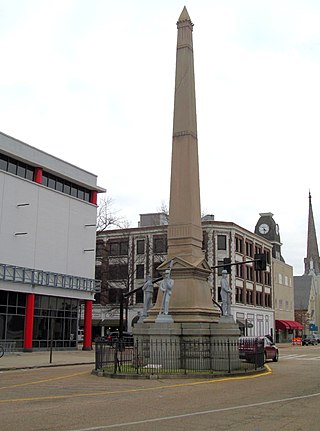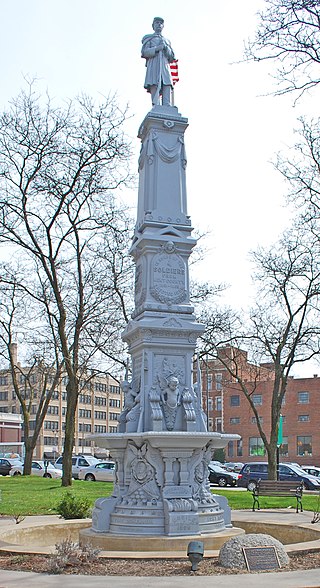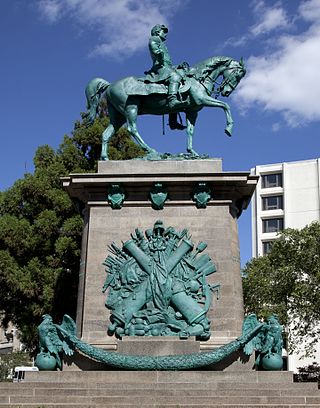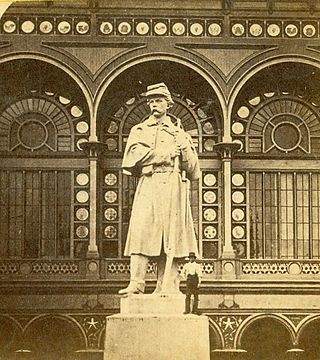
Caspar Buberl was an American sculptor. He is best known for his Civil War monuments, for the terra cotta relief panels on the Garfield Memorial in Cleveland, Ohio, and for the 1,200-foot (370 m)-long frieze on the Pension Building in Washington, D.C.

Allen George Newman III was an American sculptor, best known for his statue "The Hiker".

Ernest Moore Viquesney was an American sculptor best known for his popular World War I monument Spirit of the American Doughboy.

The Confederate Monument in Glasgow, Kentucky, built in 1905 by the Kentucky Women's Monumental Association and former Confederate soldier John A. Murray, commemorates those who gave their lives in service for the Confederate States of America. It is located on the side of Glasgow's courthouse. The Confederate soldier, made of bronze, is at parade rest, and features details such as a bedroll, canteen, kepi hat, and rifle. It stands on a limestone pedestal.

The New England state of Connecticut played an important role in the American Civil War, providing arms, equipment, technology, money, supplies, and manpower for the Union Army, as well as the Union Navy. Several Connecticut politicians played significant roles in the Federal government and helped shape its policies during the war and the subsequent Reconstruction.
Mullins of Salem, Ohio, was the most well-known American zinc ornament producer in the late nineteenth century. The foundry was in Salem, Ohio and was one of many American companies in the 1880s that through their catalogs sold ornaments nationwide, such as “urns, eagles, civic ornaments, architectural details, and even cigar store Indians.” They did not purvey grave markers, which were the sole domain of the Monumental Bronze Company of Bridgeport, Connecticut.

The Confederate Monument in Portsmouth, Virginia, was built between 1876 and 1881. It was listed on the National Register of Historic Places (NRHP) in 1997.

The Kent County Civil War Monument is an historic landmark in Grand Rapids, Michigan. The monument is in a small triangular downtown park, bounded by Division Avenue and Monroe Avenue. It was listed on the National Register of Historic Places in 2004.

Lewis County Soldiers' and Sailors' Monument is a historic American Civil War monument located at Lowville in Lewis County, New York. It was built in 1883 by Monumental Bronze Company of Bridgeport, Connecticut, and is constructed of sand-cast zinc. It is 20 feet high and 78 inches square and consists of five parts: a three stepped base, a plinth, a tapered column, a capital, and on the top a soldier.

Major General George B. McClellan is an equestrian statue in Washington, D.C. that honors politician and Civil War general George B. McClellan. The monument is sited on a prominent location in the Kalorama Triangle neighborhood due to efforts made by area residents. The statue was sculpted by American artist Frederick William MacMonnies, a graduate of the École des Beaux-Arts whose best known work is a statue of Nathan Hale in New York City. MacMonnies was chosen to design the statue following a lengthy competition organized by a statue commission, led by then Secretary of War William Howard Taft. The monument was dedicated in 1907, with prominent attendees at the ceremony including President Theodore Roosevelt, New York City mayor George B. McClellan, Jr., politicians, generals and thousands of military personnel.

The Memorial to Robert Gould Shaw and the Massachusetts Fifty-Fourth Regiment is a bronze relief sculpture by Augustus Saint-Gaudens opposite 24 Beacon Street, Boston. It depicts Colonel Robert Gould Shaw leading members of the 54th Regiment Massachusetts Volunteer Infantry as it marched down Beacon Street on May 28, 1863 to depart the city to fight in the South. The sculpture was unveiled on May 31, 1897. This is the first civic monument to pay homage to the heroism of African American soldiers.

Henry Jackson Ellicott was an American sculptor and architectural sculptor, best known for his work on American Civil War monuments.

Carl H. Conrads was an American sculptor best known for his work on Civil War monuments and his two works in the National Statuary Hall Collection at the U.S. Capitol in Washington, D.C. He was also known as Charles Conrads.

The American Volunteer – also known as The American Soldier – is a colossal granite statue that crowns the U.S. Soldier Monument and forms the centerpiece of Antietam National Cemetery in Sharpsburg, Maryland. The monument is also known as the Private Soldier Monument.

The Confederate Soldiers Monument, also known as the Confederate Dead Monument, is a Confederate memorial installed outside the Texas State Capitol in Austin, Texas. It was erected in 1903. Its sculpture was designed by Pompeo Coppini, and its base was designed by Frank Teich. The sculpture was cast by Roman Bronze Works.

White bronze is a white-coloured alloy. Examples of various alloys composed of copper, tin and zinc or composed of zinc, copper, aluminum and magnesium. A modern composition contains 55% copper, 30% tin and 15% zinc. A 1904 patent for "white bronze" is composed of 86% zinc, 9.9% copper, 4% aluminum and 0.1% magnesium.
The American Bronze Company aka American White Bronze Company was a company that produced and sold through trade catalogs, zinc statues, and memorials. It was founded in about 1885, initially as a subsidiary of the Monumental Bronze Company. In 1892, the foundry, owned by Paul Cornell, was located in Grand Crossing, Illinois where Cornell owned a watch company. Around 1900 the company moved to Chicago. The firm is best known for producing cemetery monuments and Civil War monuments, for both the Union and Confederate causes.

The Stonewall Jackson Monument in Richmond, Virginia, was erected in honor of Thomas Jonathon "Stonewall" Jackson, a Confederate general. The monument was located at the centre of the crossing of Monument Avenue and North Arthur Ashe Boulevard, in Richmond, Virginia. The bronze equestrian statue was unveiled in 1919. Along this avenue are other statues including Robert E. Lee, J. E. B. Stewart, Jefferson Davis, Matthew Maury and more recently Arthur Ashe. Thomas Jackson is best known as one of Robert E. Lee's most trusted commanders throughout the early period of the American Civil War between Southern Confederate states and Northern Union states. He rose to prominence after his vital role in the Confederate victory at the First Battle of Bull Run in July 1861, continuing to command troops until his untimely death on May 10, 1863, after falling fatally ill following the amputation of his wounded arm.

















